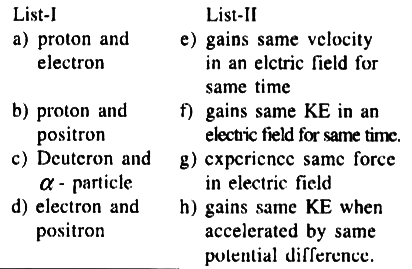List - IList - II(a)changes only in direction(e)external torque(b)zero magnitude(f)angular momentum(c)acts along axis of rotation(g)kinetic energy(d)none zero and constant (having no direction)(h)linear momentum
a-e, b-h, c-f, d-g
a-h, b-e, c-g, d-f
a-h, b-f, c-e, d-g
a-h, b-e, c-f, d-g
The correct Answer is:D
Topper's Solved these Questions
- SYSTEM OF PARTICLES AND ROTATIONAL MOTIONBOOK - AAKASH SERIESCHAPTER - SYSTEM OF PARTICLES AND ROTATIONAL MOTIONEXERCISE - EXERCISE - 1B
51 Videos
- SYSTEM OF PARTICLES AND ROTATIONAL MOTIONBOOK - AAKASH SERIESCHAPTER - SYSTEM OF PARTICLES AND ROTATIONAL MOTIONEXERCISE - EXERCISE - 2
106 Videos
- SYSTEM OF PARTICLES AND ROTATIONAL MOTIONBOOK - AAKASH SERIESCHAPTER - SYSTEM OF PARTICLES AND ROTATIONAL MOTIONEXERCISE - PRACTICE EXERCISE
99 Videos
- SURFACE TENSIONBOOK - AAKASH SERIESCHAPTER - SURFACE TENSIONEXERCISE - ADDITIONAL PRACTICE EXERCISE (PRACTICE SHEET (ADVANCED) INTEGER TYPE QUESTIONS )
8 Videos
- THERMAL PROPERTIES OF MATTERBOOK - AAKASH SERIESCHAPTER - THERMAL PROPERTIES OF MATTEREXERCISE - ADDITIONAL PRACTICE EXERCISE (LEVEL - II) PRACTICE SHEET (ADVANCED) Integer/Subjective Type Questions
2 Videos
Similar Questions
Match the column : Column-IColumn-II(Quantum, no. of mono electron atom)(Quantisation of)(A)n(P)magnitude of orbital angular momentum(B)l(Q)energy & position(C)m(R)magnetic & direction of spin angular momentum(D)s(S)direction of orbital angular momentum
View SolutionMatch the column : Column-IColumn-II(Quantum, no. of mono electron atom)(Quantisation of)(A)n(P)magnitude of orbital angular momentum(B)l(Q)energy & position(C)m(R)magnetic & direction of spin angular momentum(D)s(S)direction of orbital angular momentum
View Solution
Knowledge Check
Two bodies having moments of inertia I1andI2(I1>I2) have same angular momentum. If E1andE2 are their rotational kinetic energies,
AE1<E2BE1>E2CE1=E2DE1≥E2List−IList−II(A)nodal plane(1)Ze22r(B)p-orbital(2)λ=hmv(C)de Broglie(3)Spherical(D)Kinetic energy(4)Probability ofe−is zero(5)Dumb bell
The correct match isAABCD4521BABCD2435CABCD1532DABCD3142Match List-I with List-II : List-I:
List-IList-II(a)h(Plank's constant)(i)[MLT−1](b)E(Kinetic energy)(ii)[ML2T−1](c)V(elecic potential)(iii)[ML2T−2](d)P(linear momentum)(iv)[ML2I−1T−3]
Choose the correct answer from the options given below :A(a)→(iii),(b)→(iv),(c)→(ii),(d)→(i)B(a)→(ii),(b)→(iii),(c)→(iv),(d)→(i)C(a)→(i),(b)→(ii),(c)→(iv),(d)→(iii)D(a)→(iii),(b)→(ii),(c)→(iv),(d)→(iii)
List-IList - 2(a)m−1(e)Surface tension(b)Pa(f)Thermal capacity(c)Jk−1(g)Rydberg constant(d)Jm−2(h)Energy density
View SolutionWhen no external torque acts on a system, its angular momentum remains constant. Is the statement true ? Should kinetic energ of rotation of the system remain constant ? If yes, why , and if no, why not?
View SolutionAngle batween velocity and acceleration vectors in the following case
List-IList-II(A)Vertically projected body(e)90∘(b)For freely falling body(f)Changes from point to point(C)For projectile(g)Zero(d)In uniform circular motion(h)180∘
View SolutionMatch list I with list II
List-IList-II(A)Ratio of angular velocities of hours hand of a clock and self rotation of the earth(e)12:1(b)Ratio of angular velocities of seconds hand to minutes hand of a clock(f)60:1(c)Ratio of angular velocities of seconds hand to hours hand of a clock(g)2:1(d)Ratio of angular velocities of minutes hand to hours hand of a clock(h)720:1
View SolutionMatch List-I with List-II

View Solution
